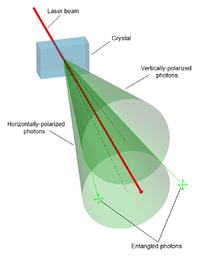
Photo from wikipedia
The superposition principle is the cornerstone of quantum mechanics, leading to a variety of genuinely quantum effects. Whether the principle applies also to macroscopic systems or, instead, there is a… Click to show full abstract
The superposition principle is the cornerstone of quantum mechanics, leading to a variety of genuinely quantum effects. Whether the principle applies also to macroscopic systems or, instead, there is a progressive breakdown when moving to larger scales, is a fundamental and still open question. Spontaneous wavefunction collapse models predict the latter option, thus questioning the universality of quantum mechanics. Technological advances allow to challenge collapse models and the quantum superposition principle more and more with a variety of different experiments. Among them, non-interferometric experiments proved to be the most effective in testing these models. We provide an overview of such experiments, including cold atoms, optomechanical systems, X-rays detection, bulk heating as well as comparisons with cosmological observations. We also discuss avenues for future dedicated experiments, which aim at further testing collapse models and the validity of quantum mechanics. Quantum mechanics radically changed our understanding of Nature. The superposition principle allows for the preparation of quantum systems in coherent superpositions of distinguishable physical configurations. This challenges our classical intuition according to which objects can only be in a one definite physical state at a time. After almost one hundred years of experimental endeavours, the validity of the superposition principle at the microscopic scale is beyond questioning. It has led to an unprecedented understanding of the behaviour of matter and light and to the development of several quantum technologies, such as the laser and the transistor, which are now part of our everyday life. Despite such success, we face a puzzling situation at the macroscopic scale: we do not experience quantum superpositions, although quantum mechanics does not set any explicit upper bound to the size that such superpositions can have. One possible explanation for the lack of observation of macroscopic quantum superpositions is that the superposition principle progressively breaks down when moving from the microscopic to the macroscopic world1–4. In this regard, spontaneous wavefunction collapse models — or simply collapse models — provide a consistent phenomenological framework for the breakdown of quantum superpositions. The collapse mechanism becomes stronger with the size and complexity of a given system, so that, while the microscopic world is quantum mechanical, the macroscopic world is classical. The collapse dynamics, which is controlled by few parameters, differs from the standard quantum dynamics. The differences can be verified experimentally, and we have recently witnessed an increasing effort in placing strong experimental bounds on the value of their parameters. There are essentially two methods to test collapse models. The most direct approach is to perform interferometric experiments, aiming at detecting quantum superpositions (or the lack thereof) with larger and larger objects5. The alternative approach is to conduct non-interferometric experiments, where the possible violation of the superposition principle is tested indirectly through various side-effects of the collapse dynamics. Despite their immediacy, interferometric experiments become significantly harder to perform when the size of the system to test grows. Non-interferometric experiments are relatively easier as they do not require one to prepare the system in a quantum superposition. Instead, they require the precise monitoring of quantities such as the position or the energy. This review addresses non-interferometric experiments and their ability to provide bounds in the parameter space of two of the most important collapse models, the Continuous Spontaneous Localization model6, 7 (CSL) and the Diósi-Penrose (DP) one1, 8. 1 Theoretical framework of collapse models Collapse models provide a mathematically and physically consistent dynamical framework, where quantum superpositions and wavepacket reduction are combined. This is achieved by embedding in the Schrödinger equation the mechanism responsible for wavepacket reduction — the not-better-specified collapse of the wavefunction to a definite state upon a measure1 ar X iv :2 20 3. 04 23 1v 1 [ qu an tph ] 8 M ar 2 02 2 Collapse noise Measurement device
Journal Title: Nature Physics
Year Published: 2022
Link to full text (if available)
Share on Social Media: Sign Up to like & get
recommendations!